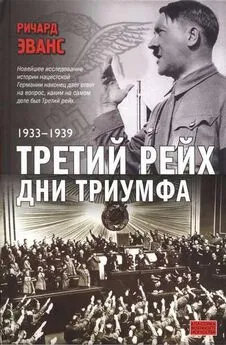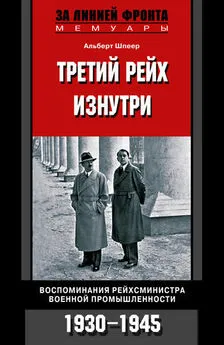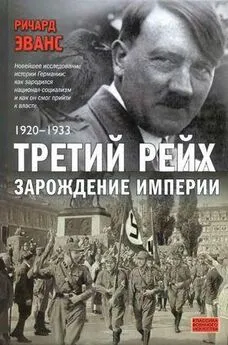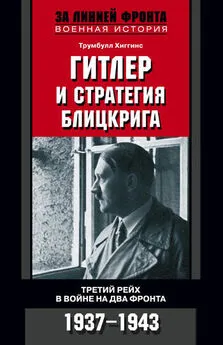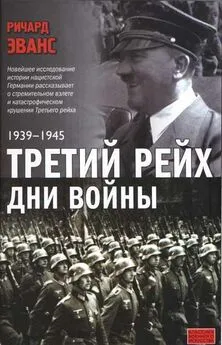Ричард Эванс - Третий Рейх. Дни Триумфа. 1933-1939
- Название:Третий Рейх. Дни Триумфа. 1933-1939
- Автор:
- Жанр:
- Издательство:ООО «Агентство прав «У-Фактория»; ООО «Издательство Астрель»
- Год:2010
- Город:Екатеринбург
- ISBN:978-5-271-30709-6, 978-5-9757-0532-7
- Рейтинг:
- Избранное:Добавить в избранное
-
Отзывы:
-
Ваша оценка:
Ричард Эванс - Третий Рейх. Дни Триумфа. 1933-1939 краткое содержание
Трилогия Ричарда Эванса — захватывающее и в то же время крайне подробное и исторически достоверное повествование о самой трагической эпохе в немецкой и европейской истории прошлого века.
Третий Рейх. Дни Триумфа. 1933-1939 - читать онлайн бесплатно полную версию (весь текст целиком)
Интервал:
Закладка:
1201
Bernd Stover, Volksgemeinschaft im Dritten Reich: Die Konsensbereitschaft der Deutschen aus der Sicht sozialistischer Exilberichte (Düsseldorf, 1993), 115-203,421.
1202
Domains (ed.), Hitler, I. 415-17.
1203
Там же, II. 892.
1204
Völkischer Beobachter, 29 сентября 1935 г., цитируется в Schoenbaum, Hitler’s Social Revolution, 67.
1205
См. выше, 268, 300-301; о взглядах Река см. дневник, 63-4.
1206
Tagebuch Luise Solmitz, 28 августа 1934 г.
1207
Выборочное сравнение см. в Overy, The Dictators, 218-64; о мнении, что Третий рейх модернизировал немецкое общество с помощью кейнсианской экономической политики и разрушения традиционных социальных институтов вроде профсоюзов, см в Werner Abelshauser and Anselm Faust, Wirtschafts- und Sozialpolitik: Eine nationalsozialistische Revolution? (Tubingen, 1983).
1208
Henry Ashby Turner, Jr, «Fascism and Modernization», у него же (ed.), Reappraisals of Fascism (New York, 1975), 117-39.
1209
См. полезное обсуждение в Ian Kershaw, The Nazi Dictatorship: Problems and Perspectives of Interpretation (4th edn, London, 2000 [1985]), 161-82; Horst Matzerath and Heinrich Volkmann, «Modemisierungstheorie und Nationalsozialismus», in Jurgen Kocka (ed.), Theorien in der Praxis des Historikers (Gottingen, 1977), 86-116; Jeremy Noakes, «Nazism and Revolution», in Noel O’Sullivan (ed.), Revolutionary Theory and Political Reality (London, 1983), 73-100. О мнении, что нацизм сознательно стремился модернизировать немецкое общество, см. в Rainer Ziteimann, Hitler: The Politics of Seduction (London, 1999 [1987]). Оно не было широко распространено, по крайней мере не в форме, предложенной Цительманом.
1210
Paul Weindling, Health, Race and German Politics between National Unification and Nazism, 1870 — 1945 (Cambridge, 1989), 60-84; Evans, The Coming of the Third Reich, 35-6; Robert N. Proctor, Racial Hygiene: Medicine under the Nazis, (London, 1988), 47.
1211
Evans, The Coming of the Third Reich, 34-8, 377-8; Hans-Walter Schmuhl, Rassenhygiene, Nationalsozialismus, Euthanasie: Von der Verhütung zur Vernichtung «lebensunwerten Lebens», 1890 — 1945 (Gottingen, 1987), 49-105.
1212
Weindling, Health, 489-503.
1213
Schumuhl, Rassenhygiene, 1543.
1214
Evans, The Coming of the Third Reich 37, 145, 377-80; Proctor, Racial Hygiene, 10-104 (о комитете Фрика см. на стр. 95); Schmuhl, Rassenhygiene, 154-68; Christian Ganssmuller, Die Erbgesundheitspolitik des dritten Reiches: Planung, Durchführung und Durchsetzung (Cologne, 1987), 34-115; Jeremy Noakes, «Nazism and Eugenics: The Background to the Nazi Sterilization Law of 14 July 1933», in Roger Bullen etal. (eds.), Ideas into Politics: Aspects of European History 1880 — 1950 (London, 1984), 75-94.
1215
Gisela Bock, Zwangssterilisation im Nationalsozialismus: Studien zur Frauenpolitik und Rassenpolitik (Opladen, 1986), 230-32.
1216
Ganssmuller, Die Erbgesundheitspolitik, 45-6: еще 40 000 были стерилизованы в областях, аннексированных Германией в 1938 — 1939 гг.
1217
Michael Burleigh, Death and Deliverance: «E thanasia» in Germany c. 1900 — 1945 (Cambridge, 1994), 56-66.
1218
Цитируется в Andrea Brucks, «Zwangssterilisation gegen «Ballastexistenzen»», in Klaus Frahm et al. (eds.), Verachtet — verfolgt — vernichtet: Zu den «vergessenen» Opfern des NS-Regimes (Hamburg, 1986), 103-8.
1219
Longerich, Politik, 61-2.
1220
Joachim Muller, Sterilisation und Gesetzgebung bis 1933 (Husum, 1985); Wachsmann, Hitler’s Prisons, 151.
1221
Michael Schwartz, Sozialistische Eugenik: Eugenische Sozialtechnologien in Debatten und Politik der Deutschen Sozialdemokratie 1890 — 1933 (Bonn, 1995).
1222
Whchsmann, Hitler’s Prisons, 149-56.
1223
Klaus-Dieter Thomann, «»Krüppel sind nicht minderwertig.» Körperbehinderte im Nationalsozialismus», in Meinel and Voswinckel (eds.), Medizin, 208 -20, 208-12, с цитированием Wilhelm Frick, «Bevolkerungs-und Rassepolitik», in Elsbeth Unverricht (eds.), Unsere Zeit nd Wir: Das В ch der de tschen Fra (Gauting, 1933), 97-109, 103.
1224
Thomann, «Krüppel», 213-16.
1225
Rossmeissl, «Ganz Deutschland», 134.
1226
Proctor, Racial Hygiene, 95-101; Stefan Kuhl, The Nazi Connection: Eugenics, American Racism, and German National Socialism (New York, 1994).
1227
Alberto Spektorowski and Elisabeth Mizrachi, «Eugenics and the Welfare State in Sweden: The Politics of Social Margins and the Idea of a Productive Society», Journal of Contemporary History, 39 (2004), 333-52; Alex Duval Smith and Maciej Zeremba, «Outcasts from Nordic Super-Race», Observer, 24 августа 1997 г., 6.
1228
Proctor, Racial Hygiene, 171; о социальной политике протестантов см. в Sabine Schleiermacher, Sozialethik im Spann ngsfeld von Sozial- nd Rassenhygiene Der Mediziner Hans Harmsen im Centralausschuss für die Innere Mission (Husum, 1998).
1229
Proctor, Racial Hygiene, 123.
1230
James Wjycke, Birth Control in Germany 1871 — 1933 (London, 1988), 154; Evans, The Coming of the Third Reich, 375-8; Stibbe, Wsmen, 43; Henry P. David et al., «Abortion and Eugenics in Nazi Germany», Population and Development Review, 14 (1988), 81-112.
1231
Цитируется в Proctor, Racial Hygiene, 124.
1232
Richard J. Evans, The Feminist Movement in Germany 1894 — 1933 (London, 1976), 255-60; у него же, The Coming of the Third Reich, 185-6.
1233
Stibbe, Women, 34-40; Jill Stephenson, The Nazi Organization of Women (London, 1981), 97-125; у него же, «The Nazi Organisation of Women, 1933 — 1939», in Stachura (ed.), The Shaping, 186-209. Некоторые из одиннадцати детей Шольц-Клинк умерли в младенчестве.
1234
Irmgard Wfeyrather, Muttertag und Mutterkreuz: Die Kult um die «deutsche Mutter» im Nationalsozialismus (Frankfurt am Main, 1993); Susanna Dammer, «Kinder, Küche, Kriegsarbeit — Die Schulung der Frauen durch die NS-Frauenschaft», in Frauengruppe Faschismusforschung (ed.), Mutterkreuz, 215-45; Karin Hausen, «Mother’s Day in the Wfeimar Republic», in Renate Bridenthal et al. (eds.), When Biology Became Destiny, 131-52; у него же «The «German Mother’s Day» 1923 — 1933», in Hans Medick and David Sabean (eds.), Interest and Emotion: Essays in the Study of Family and Kinship (Cambridge, 1984), 371-413.
1235
Stibbe, Wbmen, 34-40; Claudia Koonz, Mothers in the Fatherland: Wbmen, the Family and Nazi Politics (London, 1988 [1987]), 177-219; Stephenson, The Nazi Organization, 130-77; Pine, Nazi Family Policy, 47-81; Michael Kater, «Die deutsche Elternschaft im nationalsozialistischen Erziehungssystem. Ein Beitrag zur Sozialgeschichte der Familie», Vierteljahrschrift für Sozial- und Wirtschaftsgeschichte, 67 (1980), 484-512; Dammer, «Kinder, Küche, Kriegsarbeit».
1236
Pine, Nazi Family Policy, 88-116; Dorothee Klinksiek, Die Frau im NS-Staat (Stuttgart, 1982), 93; Jill Stephenson, «Reichsbund der Kinderreichen: The League of Large Families in the Population Policy of Nazi Germany», European Studies Review, 9 (1979), 350-75.
1237
Marschalck, Bevolkerungsgeschichte, 158.
1238
Gisela Bock, «Antinatalism, Maternity and Paternity in National Socialist Realism», in Crew (ed.), Nazism, 110-40, 124.
1239
Marschalck, Bevolkerungsgeschichte, 159.
1240
Proctor, Racial Hygiene, 126.
1241
Stibbe, Women, 53-4; Bock, Zwangssterilisation, 166-7.
1242
Pine, Nazi Family Policy, 16-18; Gabriele Czamowski, « «The Value of Marriage for the Volksgemeinschaft»: Policies towards Women and Marriage under National Socialism», in Richard Bessel (ed.), Fascist Italy and Nazi Germany: Comparisons and Contrasts (Cambridge, 1996), 94-112, 107-8; Stephenson, Women in Nazi Society, 41-3.
1243
Ganssmuller, Die Erbgesundheitspolitik, 132-47.
1244
Hohne, The Order, 130-46; Pine, Nazi Family Policy, 38-46; Catrine Clay and Michael Leapman, Master Race: The Lebensbom Experiment in Nazi Germany (London, 1995).
1245
Irene Guenther, Nazi Chic? Fashioning Women in the Third Reich (Oxford, 2004), 91-141.
1246
Там же, 91-141, 167-201.
1247
Таким образом, главный спор 1980-х между работой Claudia Koonz, Mothers in the Fatherland, где подчеркивается создание защищенной домашней сферы и вовлеченности, а иногда даже поощрении женщинами насилия и ненависти, которые демонстрировали мужчины в общественной жизни, и Bock, «Anti-Natalism», в которой делается упор на то, что женщины были жертвами все более директивной, жестокой и негативной политики государства в отношении женщин как будущих матерей, в большой степени основан на неправильном понимании — см. Adelheid von Saldem, «Victims or Perpetrators? Controversies about the Role of Women in the Nazi State», in Crew (ed.), Nazism, 141-65; и Dagmar Reese and Carola Sachse, «Frauenforschung zum Nationalsozialismus. Eine Bilanz», in Lerke Gravenhorst and Carmen Tatschmurat (eds.), Tochter-Fragen: NS-Frauengeschichte (Freiburg, 1990), 73-106.
1248
Maria S. Quine, Population Politics in Twentieth-Century Europe: Fascist Dictatorships and Liberal Democracies (London, 1996); Richard Stites, The Wsmen’s Liberation Movement in Russia: Feminism, Nihilism, and Bolshevism, 1860 — 1930 (Princeton, N.J., 1978).
1249
Sybil H. Milton, «»Gypsies» as Social Outsiders in Nazi Germany», in Gellately and Stoltzfus (eds.), Social Outsiders, 212-32, приводит намного более высокие цифры, в районе 35 000 (212). Как отмечается в Guenter Lewy, The Nazi Persecu tion of the Gypsies (New York, 2000), 1-14, в Германии стало распространено называть цыган по их племенным названиям (синти и рома, Roma, хотя самую малочисленную группу, лаллери, обычно неявно опускали), поскольку нацисты использовали термин Zigeuner для названия цыган в целом. Аргументы против использования этого термина перечисляются в Burleigh and Wippermann, The Racial State, 113. Однако то, что его использовали нацисты, не делает его уничижительным само по себе, и, как справедливо отмечает Леви, «некоторые цыганские авторы настаивали на продолжении использования этого термина с целью сохранить историческую преемственность и выразить солидарность с теми, кого преследовали под этим именем» (ix). Следом за Леви далее используется термин «цыган».
Читать дальшеИнтервал:
Закладка:
